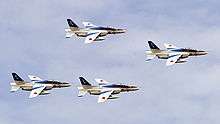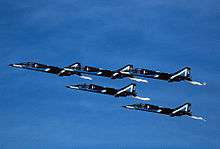Blue Impulse
| Blue Impulse 11 Squadron 4th Air Wing | |
|---|---|
|
Blue Impulse (T-4) | |
| Active | April 12, 1960 – present |
| Country |
|
| Branch |
|
| Type | Aerobatics |
| Role | Aerobatic maneuver |
| Garrison/HQ | Matsushima Air Base |
| Motto(s) | Challenge for the Creation. |
| Colors |
Blue White |
| Insignia | |
| Identification symbol |
 |
| Aircraft flown | |
| Trainer |
9 Kawasaki T-4s *Note: two aircraft are spares |
Blue Impulse (ブルーインパルス Burū Inparusu), (currently 11 Squadron 4th Air Wing, previously 21 Squadron 4th Air Wing), is the aerobatic demonstration team of the Japan Air Self-Defense Force (JASDF). The team was founded in 1960 as a team of six F-86 Sabres. They changed mounts to the Mitsubishi T-2 in 1980 and then to the Kawasaki T-4 in 1995. They are based at Matsushima Air Base, which was heavily damaged by the 2011 Tōhoku earthquake and tsunami.
Aircraft
| Aircraft | Origin | In Service * | Service ** | reference column |
|---|---|---|---|---|
| North American F-86F Sabre | | 34 | 1960–1981 | JASDF Technical Research Section. 5 aircraft formation. |
| Mitsubishi T-2 | | 11 | 1982–1995 | 4 AW 21 Sq. Technical Research Section. 6 aircraft formation. |
| Kawasaki T-4 | | 11 | 1995– | 4 AW 11 Sq. 6 aircraft formation. |
* Number of aircraft used by the Blue Impulse acrobatic team.
** Aircraft service with the Blue Impulse acrobatic team.
History
The first unofficial Japanese aerobatic team was formed in 1958 at Hamamatsu Air Base, flying Mitsubishi-built North American F-86F Sabres without a special colour scheme, disbanded after four demonstrations.
In 1959 the USAF Thunderbirds visited Japan and inspired JASDF commanders to establish an official aerobatic team. In 1960 the new team was formed at Hamamatsu airbase flying five F-86Fs, with three of the pilots coming from the 1958 team.
The first demonstration of the "Tenryū" team, (named after the Tenryū River near the air base), was on 4 March 1960 at Hamamatsu, the name was found to be hard to pronounce in western languages, so the team was renamed Blue Impulse. The aircraft were equipped with smoke generators using five different colours for each aircraft: white, red, blue, green and yellow and painted in silver, light blue, blue and pink; on the leader's aircraft, the blue is replaced by gold. Later, in 1961, all five aircraft received a special paint scheme of overall white with blue flashes.
In 1964, Blue Impulse performed at the opening of the 1964 Summer Olympics in Tokyo, drawing the Olympic rings in the air with coloured smoke. In 1970, at the opening of Expo '70 in Osaka, the team drew "Expo '70" in the air.
In February 1982, after 545 air demonstrations, Blue Impulse replaced the Sabres with Mitsubishi T-2 trainers, performing their first show with the new aircraft was on 25 June 1982 at the team's new Matsushima airbase.
At Expo '90 in Osaka, Blue Impulse performed at the opening event and drew the "Expo '90" logo in the air.
The team's last performance with the Mitsubishi T-2 was in December 1995, after 175 demonstrations with these aircraft. The new Blue Impulse aircraft became the Japanese-built Kawasaki T-4 trainer, and the first show with these aircraft was on 5 April 1996.
In 1997, the team made their first foreign debut at the Nellis Air Force Base air show in Nevada, USA.
In 1998 Blue Impulse performed at the Winter Olympics in Nagano, Japan.
Blue Impulse also performed at the 2002 FIFA World Cup; on 4 June 2002, they performed at the opening of the Japan versus Belgium match.
Accidents and incidents
Data from:[1]
- 21 July 1961
- F-86F-40 Sabre, 02-7976, crashed during aerobatic training into the sea, near Cape Irago, Tahara, Aichi. The pilot, Major Katou Matsuo, was killed.
- 4 November 1965
- F-86F-40 Sabre, 02-7975, crashed near the west end of the runway at Hamamatsu AB during aerobatic training. First Lieutenant Joumaru's condition after the incident is uncertain.
- 4 November 1972
- F-86F-40 Sabre, 72-7773, crashed at or near the Iruma River, whilst returning to base after a demonstration flight. First Lieutenant Kaneko ejected safely at 210 m (700 ft).
- 14 November 1982
- T-2B Blue Impulse #4, 19-5174, crashed during a down-ward bomb-burst manoeuvre at a Hamamatsu air display, having failed to pull up in time and crashed into a building in Takaoka, Miyazaki, killing the pilot and injuring 13 people on the ground, as well as damaging 28 civilian houses and about 290 cars. This accident brought performances a halt for the remainder of the year.
- 4 July 1991
- Over the Pacific Ocean, T-2A, 59-5112 and T-2B,19-5172, (#2 and #4), collided during a training flight after flying into sea fog near Mount Kinka, Miyagi Prefecture, causing suspension of demonstration flights for a year. Captain Hamaguchi Seiji and Captain Shikichi Yutaka were both killed.
- 4 July 2000
- Aircraft #5 and #6 collided about 25 km (16 mi) East of Matsushima Air Base, claiming the lives of three team members.
- 20 March 2002
- A T-4 suffered a bird strike.
- 29 Jan 2014
- Two Blue Impulse T-4s collided during a four-ship practice flight 72 km (45 mi) from Matsushima Air Base, both aircraft landed safely with no injures. The Leader's aircraft (#1) had nose damage, while the other involved aircraft, #2, lost half of its left horizontal stabiliser.
- 14 October 2006
- T-4 #5 suffered a bird strike at Gifu AB during training for an airshow but landed safely.
Gallery
References in pop culture
The mercenary air team "Red Impulse" and its leader from the anime series Science Ninja Team Gatchaman take their name from the Blue Impulse.
When characters in another anime, Urusei Yatsura, are hit with enough force to send them flying into the distance, they sometimes shout "Blue Impulse!"
The team have since been immortalised in its own videogame, titled Aero Dancing featuring Blue Impulse.
The flight demonstration team called "Green Impulse" in the anime series Hyperdimension Neptunia: The Animation might have taken their name from the Blue Impulse.
The aerobatics team in the anime 801 T.T.S. Airbats is called Blue Impulse.
References
- ↑ "BLUE Impulse Losses & EJECTEES". Retrieved 27 August 2016.
External links
| Wikimedia Commons has media related to Blue Impulse. |
- Japan Air Self-Defense Force - Blue Impulse Official Site (Japanese)
- Blue Impulse Museum (Japanese)
- Blue Impulse Fan Site (Japanese)








01.jpg)
.jpg)